
Sand Dunes of Jericoacoara, BRAZIL
| Translate: EspaŮol - FranÁais - Deutsch - Italiano - PortuguÍs - Japanese - Korean - Chinese |

Sand Dunes of Jericoacoara, BRAZIL
| Translate: EspaŮol - FranÁais - Deutsch - Italiano - PortuguÍs - Japanese - Korean - Chinese |

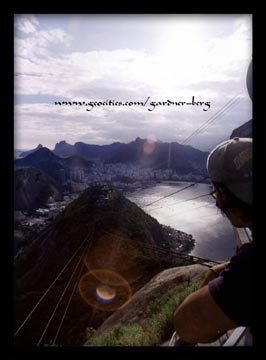 MARCH 6, 2001 -- A warm sunny morning, our packs strapped to our backs and a short walk from the campgrounds to the Argentina/Brazil border control. Hot and humid by 9am. After exit formalities from Argentina, we then flag down a bus to the Brazilian side for entry. Onward to the city of Foz do Iguacu situated on the opposing side of the Iguazu River. Here we purchase bus tickets to Rio de Janiero leaving the rodoviaria (long distance bus station) at noon.
MARCH 6, 2001 -- A warm sunny morning, our packs strapped to our backs and a short walk from the campgrounds to the Argentina/Brazil border control. Hot and humid by 9am. After exit formalities from Argentina, we then flag down a bus to the Brazilian side for entry. Onward to the city of Foz do Iguacu situated on the opposing side of the Iguazu River. Here we purchase bus tickets to Rio de Janiero leaving the rodoviaria (long distance bus station) at noon.
From just a short river crossing, our very limited Spanish is made redundant; we're now in Portuguese-speaking country. The friendly, patient approach coupled with a lot different facial expressions and hand gestures was, for us,
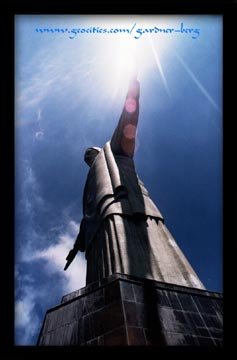 all we needed. There is a huge contrast between the 2 sides of the border, not only in language, but also in racial make-up, general behaviour, food and drink and, of course, the prices.
all we needed. There is a huge contrast between the 2 sides of the border, not only in language, but also in racial make-up, general behaviour, food and drink and, of course, the prices.
The immense size of Brazil is a dominating fact of this tropical world. Its 3,287,000 sq.miles is large enough to hold mainland USA with room for an extra Texas. Our introduction into Brazil begins in the southern highlands of the River Plate Basin which possesses the country's most fertile lands, coffee plantations, minerals, railroads, manufacturing centres and population. Most of Brazil falls within the tropical zone, but the large plateau regions of 300 to 900m in altitude provides a mild climate.

MARCH 7, 2001 -- After 12 hours, we arrive in Brazil's most recognized city - Rio de Janeiro, home of the Samba and venue of the world famous Rio Carnival; a city of extravagance and poverty. Over 10 million strong, Rio is a modern mixture of sun, sand, sea, culture and fantasy. It's a crowded urban centre fortunate enough to be set in a picture postcard setting.
We make use of the fast, cheap and convenient Metro line for orientation and to cover a few of the city's tourist sites: Corcovado, Pao do Acucar, Copacabana and Ipanema Beaches.
 MARCH 16, 2001 -- We check out of our hotel in Catete and make our way to the bus station to arrange transport to Brasilia for a brief transit stop and a connection to the northern coastal city of Recife. The road between Rio and Brasilia crossed the state of Minas Gerais - the General Mining District. Between 1710 and 1760, this state produced about 500 metric tons of gold, an amount equivalent to half the entire world production in past centuries. The gold flowed to London via Lisbon in sufficient volume to enable the British pound to become the first monetary unit to be placed on a gold standard, and to give European capitalism a powerful push forward. Today, Minas Gerais is very much a diversified mining, industrial, and agricultural state.
MARCH 16, 2001 -- We check out of our hotel in Catete and make our way to the bus station to arrange transport to Brasilia for a brief transit stop and a connection to the northern coastal city of Recife. The road between Rio and Brasilia crossed the state of Minas Gerais - the General Mining District. Between 1710 and 1760, this state produced about 500 metric tons of gold, an amount equivalent to half the entire world production in past centuries. The gold flowed to London via Lisbon in sufficient volume to enable the British pound to become the first monetary unit to be placed on a gold standard, and to give European capitalism a powerful push forward. Today, Minas Gerais is very much a diversified mining, industrial, and agricultural state.
During the 1950's Brazil, under the presidency of Juscelino Kubitschek, was going through a period of false optimism. The optimism and confidence was such that President Kubitschek pushed forward a determination to inaugurate the new federal capital, Brasilia on April 21, 1960 succeeding the long-established Rio de Janeiro. Economically hazardous and enormously expensive, it was criticized
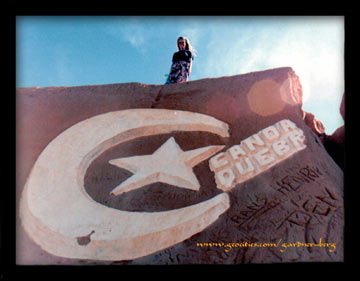 on all fronts. The dream capital was more symbolic in character - with its residences concentrated in the 'bent bow' shape and the Congress buildings, Presidential palace, museums, and the Convention Centre all placed along a long, wide road that dissects the centre of the 'bow'. It's now a UNESCO World Heritage Site.
on all fronts. The dream capital was more symbolic in character - with its residences concentrated in the 'bent bow' shape and the Congress buildings, Presidential palace, museums, and the Convention Centre all placed along a long, wide road that dissects the centre of the 'bow'. It's now a UNESCO World Heritage Site.
We head north for about 300 miles from the Federal District running just inside the eastern portion of the Goias state, skimming the fringes of the Amazon Basin, then abruptly turning east into the Bahia state toward Salvador. The rains of Bahia meets our bus head on. Brazil's characteristic red soil gets added to the water-filled potholes of these damaged sealed roads. By the time we reach Recife the bus will have a brand new 'paint job'.
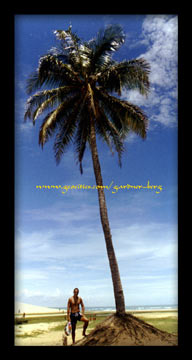 Bahia is 'African Brazil'. During the 1500's, the wealthy settlers of this part of the country established the sugar cane crop and found themselves in need of labour. Indians were too few in numbers. So, African slaves were imported in considerable numbers (around 2 million) and put into hard labour. The northeast soon became the world's largest sugar producer of the 18th century.
Bahia is 'African Brazil'. During the 1500's, the wealthy settlers of this part of the country established the sugar cane crop and found themselves in need of labour. Indians were too few in numbers. So, African slaves were imported in considerable numbers (around 2 million) and put into hard labour. The northeast soon became the world's largest sugar producer of the 18th century.
During the 1970's Brazil was forced into a recession from rising interest rates and a world oil crisis. The production of ethanol from sugar was introduced as part of an alcohol fuel program becoming the world's most successful alternative energy plan saving the nation billions of dollars on energy imports. Fuel pumps all over Brazil dispense 'alcohol fuel' (ethanol/petroleum mixture); literally 'green' petrol.
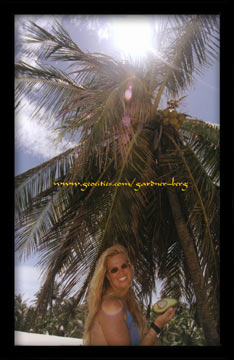 MARCH 19, 2001 -- From Salvador we follow the railway lines along the northeastern coast to Recife's rodoviaria located on the outskirts of the city. A convenient above-ground Metro line allows us easy transport to cover the 12km gap between the bus station and the city centre. Then it's a walk across the bridge to the Boa Vista area in search for a place to stay. Baroque architecture dominating the city centre and its northern districts, still stands as a reminder of the long reach of Portugal's past opulence and power.
MARCH 19, 2001 -- From Salvador we follow the railway lines along the northeastern coast to Recife's rodoviaria located on the outskirts of the city. A convenient above-ground Metro line allows us easy transport to cover the 12km gap between the bus station and the city centre. Then it's a walk across the bridge to the Boa Vista area in search for a place to stay. Baroque architecture dominating the city centre and its northern districts, still stands as a reminder of the long reach of Portugal's past opulence and power.
Boa Viagem is the middle/upper class district which covers an 8km stretch of sandy beach overlooking the Atlantic Ocean. Brazil's largest shopping mall is here. A good place to escape the oppressive heat and the bustling crowds.
 MARCH 22, 2001 -- Noon check out and it's off again back to the bus station for an overnight trip to Fortaleza - the nation's 5th largest city. Our bus goes on a roundabout route cutting inland to Teresina then east back to the coast. We arrive 8am the following morning.
MARCH 22, 2001 -- Noon check out and it's off again back to the bus station for an overnight trip to Fortaleza - the nation's 5th largest city. Our bus goes on a roundabout route cutting inland to Teresina then east back to the coast. We arrive 8am the following morning.
It's early but the station is already crowded. With our packs on we stick out like 2 sore thumbs, especially for bus company touts and taxi drivers that approach to make offers.
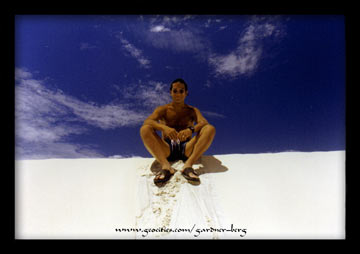 A three and a half hour ride south along the coast from Fortaleza is Canoa Quebrada - a small village surrounded by huge coloured sand dunes. Beach buggies are normal forms of traffic here. Tourist numbers are low at the moment, so there was room for price negotiation on accommodation. A few days of relaxation in the sun would be a good idea to stretch our muscles and straighten out some joints from the long bus travel.
A three and a half hour ride south along the coast from Fortaleza is Canoa Quebrada - a small village surrounded by huge coloured sand dunes. Beach buggies are normal forms of traffic here. Tourist numbers are low at the moment, so there was room for price negotiation on accommodation. A few days of relaxation in the sun would be a good idea to stretch our muscles and straighten out some joints from the long bus travel.
MARCH 28, 2001 -- A fast 3 hour return to Fortaleza had everyone on the bus (including ourselves) feeling nausea - the driver was an Andretti wannabe. The Fortaleza rodoviaria actually had good places to eat and with its open air construction the heat and humidity allowed the ice cream stands to make a good profit.
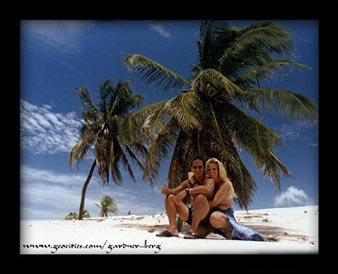 6.30pm - This time we bus north for about 5 hours to Jijoca connecting directly to an open-seated truck. We head into the night, crossing sand dune territory to the small fishing village of Jericoacoara (or just 'Jeri').
6.30pm - This time we bus north for about 5 hours to Jijoca connecting directly to an open-seated truck. We head into the night, crossing sand dune territory to the small fishing village of Jericoacoara (or just 'Jeri').
We arrived to a waiting group of hotel touts at 1am. Aggressive as they all were except for a shy, soft-spoken young lady who had been pushed to the back of the group - we were tired, but she caught our attention; we ourselves get enough of that throughout Latin America. We followed her to the little 3-room guesthouse that she and her husband own with their 3 children.
Jeri has become our favourite sandy beach. Wide open spaces, high and wide sand dunes, and best of all - quiet and tranquil.
Photos and Text Copyright © 1999-2001 Gardner-Berg. All rights reserved.
Sources of Further Reading-
Davis, Wade. "One River: Exploration and Discoveries in the Amazon Rain Forest" 1997.
Cesar Pino, Julio. "Family and Favela" 1997.
Galembo, Phyllis. "Divine Inspiration: From Benin to Bahia" 1998.
Nagle, Robin. "Claiming the Virgin: The Broken Promise of Liberation Theology in Brazil" 1997.

